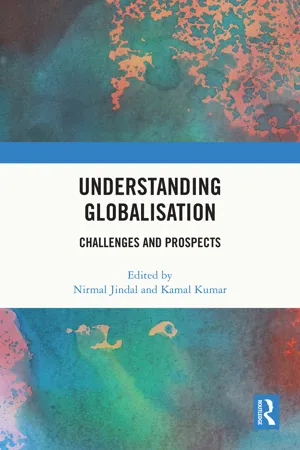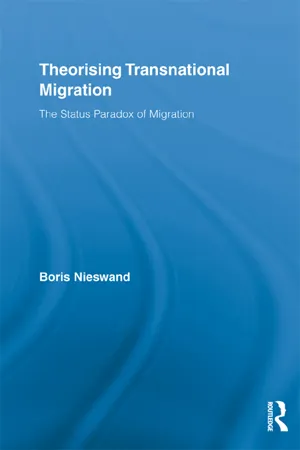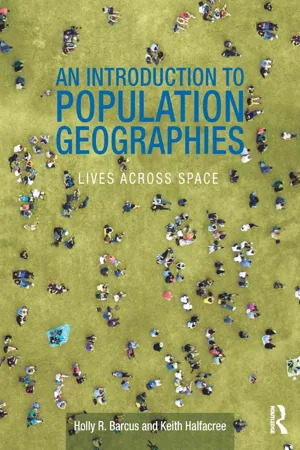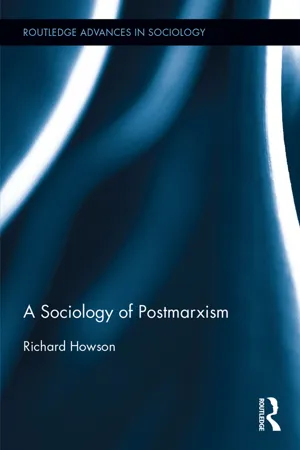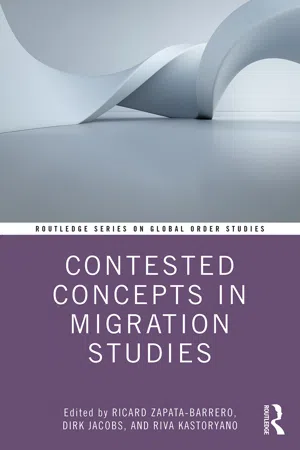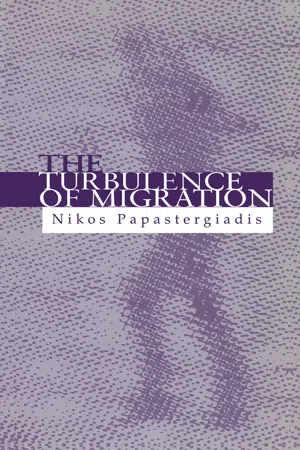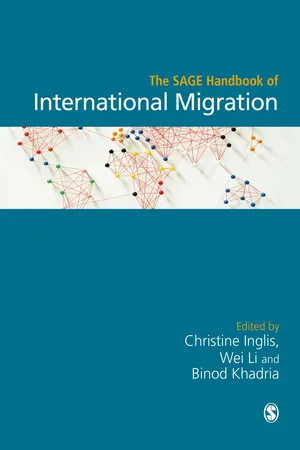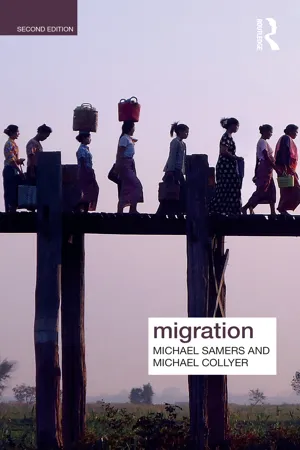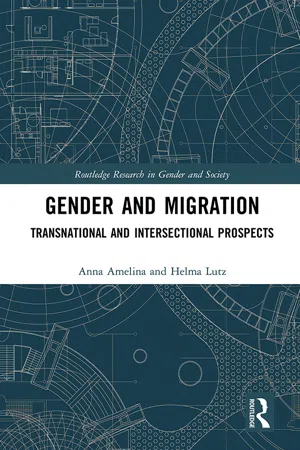Social Sciences
Migration and Globalisation Sociology
Migration and globalization in sociology refer to the movement of people across national borders and the interconnectedness of societies on a global scale. This field of study examines how migration patterns are influenced by economic, political, and social factors, and how they, in turn, impact societies and cultures. It also explores the power dynamics and inequalities that shape migration processes in a globalized world.
Written by Perlego with AI-assistance
Related key terms
Related key terms
1 of 4
Related key terms
1 of 3
11 Key excerpts on "Migration and Globalisation Sociology"
- eBook - ePub
Understanding Globalisation
Challenges and Prospects
- Nirmal Jindal, Kamal Kumar(Authors)
- 2023(Publication Date)
- Routledge India(Publisher)
10 Globalisation and Human Migration Interlinkages and Issues Rityusha Mani TiwaryDOI: 10.4324/9781003434504-11Introduction
Migration is the movement of populations from one place to another; the notion of human movement is central to both globalisation and migration. As the forces of globalisation intensified, migration also intensified. Therefore, migration appears as almost an inevitable implication of globalisation. The experiences of both the immigrants settling and adjusting in the receiving countries and the host populations traverse through various factors: several demographic parameters including age, race, gender (see Borjas 1985 ; Chiswick 1978), education, religion, and culture. The interface of migrating and native populations leaves various impacts on cultures, job competition, claims on public resources, social security benefits, and life choices. Factors behind migration include macro (political, demographic, socio-economic, and environmental), meso (information technology and communication, scarcity of land and diaspora population) and micro reasons (cultural, community preferences, and individual choices; Castelli 2018 ).Migration has emerged as a critical universal concern in contemporary times as it represents the intersection between the Global South and the Global North with many serious implications on all aspects of human interaction, presenting complex challenges to governance. Furthermore, there are deep impacts on the issues of efficient allocation of resources, knowledge transfer, and technological advancement. In the last decade, migration has been in the news for its influences on election outcomes, its ability to invoke populist policies, and instigation of debates on culture, religion, and humanitarian rights. Whether internal or external, migration greatly impacts the critical infrastructures of health, education, public facilities, education, social security, childcare, law and order agencies, and employment opportunities. Moreover, cities’ growth and development plans demand new laws regulating internal and external migration. Against this backdrop, the chapter intends to understand various dimensions of migration, various approaches to migration, global trends in migration, the ways it impacts the entrenched inequalities and imbalances vis-à-vis the Global South and North. Finally, the chapter looks at India’s case study, emphasizing its experiences of migrant workers’ crisis during the COVID-19 pandemic, and concludes with some policy insights. - eBook - ePub
Social Work and Integration in Immigrant Communities
Framing the Field
- Kathleen Valtonen(Author)
- 2016(Publication Date)
- Routledge(Publisher)
Migration – in-migration and out-migration – is indeed closely related to the social openness of societies, but a comprehensive frame for migration would recognize the interrelatedness of economic, political and social factors in shaping the characteristics of very diverse migration flows and processes. Migration is an integral part of global processes, and in the long run, probably one of the most socially influential. In one sense migration arises from, and is shaped by economic, political and social processes. In another, nearly all societies are being impacted in different ways by the migration flows.Delanty (2009 , p.1) describes the way that globalization processes have transformed social relations especially in the context of ‘the overwhelming interconnectivity of the world’. In his analysis of globalization, Beck (2000) draws attention to how national states are being criss-crossed and undermined by transnational actors. Yet globalization is not yet overcoming the state. Globalization is a current phase of social change, while the state itself has been able to respond to changing circumstances for centuries. Adaptability has been its hallmark and central to its success (Bisley, 2007 ). State boundaries are very firmly in place, and still constitute a formidable factor in determining the nature and volume of migration flows and the intertwined destinies of those who would cross interstate borders.Mehdi (2004) states that when viewed from a historical perspective, globalization does not signify the emergence of an economic system that is radically different from the one we now have. As pointed out by Bisley (2007) global linkages between disparate human communities have existed for thousands of years. An extensive economy was established between the eighth and thirteenth centuries by the Islamic caliphate. It extended over conquered lands of North Africa, parts of Europe and the Middle East, and the trading networks of Eastern Africa and Central and Eastern Asia. The ‘vital elements of human existence’ were being shaped in former periods of history by inter-continental linkages of trade, investment, conquest and exploration’ (Bisley, 2007 - eBook - ePub
- Boris Nieswand(Author)
- 2012(Publication Date)
- Routledge(Publisher)
Because of the epistemological dualism which for a long time dominated African migration studies, the ‘tribesman in the city’ was the paradigmatic type of migrant in all approaches cited. Although the migrants coming from the rural hinterland to the cities ‘overstepped’ the line of division between the modern and the traditional system, the differentiation itself remained fundamental to the analytical frameworks according to which this type of mobility was selected as most remarkable.Both the nation-state paradigm of migration studies and rural–urban migration studies affirmed imaginaries of society as a relatively stable, internally homogenous and unitary system from which cross-border movements by definition remained a deviation. In this sense, the binary of traditional and modern society as well as imaginaries of the national society are variations of the same basic idea of society.17MIGRATION AND WORLD SOCIETYSince the 1980s, the social sciences have experienced a general shift towards global perspectives on their subjects, which has also affected the study of migration. This facilitated the development of new concepts or the revival of older concepts, respectively, which emphasised the relevance of cross-border forms of sociality among migrants and their descendants. In the following, I will focus on three concepts which were developed to theorise migration-related forms of transnational and global interconnections: first, diaspora, second, global ethnoscape and, third, transnational social field.The process of globalisation went through several waves of intensification of global interactions in the past, which were followed by phases of decreasing intensity of global exchange (Harvey 1989; Robertson 1990; Wimmer and Glick Schiller 2002a; Friedman 2004: 64–65). While most of the social science literature deals with the last wave, which started in the 1970s and profited from the end of the Cold War, the period between 1880 and 1925 was often depicted as a ‘crucial take-off period of globalisation’ (Robertson 1990: 19). - eBook - ePub
An Introduction to Population Geographies
Lives Across Space
- Holly R. Barcus, Keith Halfacree(Authors)
- 2017(Publication Date)
- Routledge(Publisher)
CHAPTER 5Placing human migration5.1 INTRODUCTION: DEFINING MIGRATION
5.1.1 What is migration?
Migration remains the most widely studied and examined element within Population Geography (Boyle 2003, 2004). Moreover, whilst Geographers have played a pivotal role in shaping our contemporary understanding of it, the topic is of interest to numerous academic disciplines, including Demography, Sociology, Political Science, Economics and Anthropology (Brettell and Hollifield 2008a). In this respect, approaching migration as it occurs within the life course has considerable potential for bringing together a scattered body of scholarship often fragmented by “disciplinary partitioning” (Olwig and Sørensen 2002: 7).But what exactly is migration? Initially put, as in a recent textbook, it is “the movement of people to live in a different place” (Holdsworth et al. 2013: 96) or a “permanent change in residence.” It is residential relocation. Or, as expressed in UK and US censuses, a migration is deemed to have occurred when one’s “usual address” has changed within the last 1 or 5 years, respectively (ONS 2013; USCB 2013). Simple, then, one might think! However, as Holdsworth et al. (2013: 98) also noted, careful consideration of these definitions immediately raises a host of questions: what precisely is meant by “different place,” “live in,” “permanent,” or “usual address”? Consequently, by the end of the present chapter, “migration” will have been demonstrated to be at least as complex and multi-dimensional a concept as Chapter 4 revealed “fertility” to be.Starting with the idea of “different place,” the type of areal unit(s) involved in a migration is an initial important consideration when defining it specifically. A crucial starting point is whether a political boundary is crossed during a move. For example, an individual could move from one county to another within the same US state or from one state to another. Both moves are conventionally described as intra-national or internal migration, because neither involves leaving the US. In contrast, a move from the US to Canada, crossing an international border, is an international migration - eBook - ePub
Migration Theory
Talking across Disciplines
- Caroline B. Brettell, James F. Hollifield(Authors)
- 2022(Publication Date)
- Routledge(Publisher)
Geographers are primarily interested in spatial and scalar relationships. In migration research their attention is therefore directed, as Price (this volume) points out, to mapping migration flows, tracking patterns of spatial assimilation, and shifting or jumping scales from the local to the global. These foci have resulted in the introduction of new concepts such as “heterolocalism” and ethnoburbs into the literature of migration studies. Geographers, like anthropologists, explore not only intersectionality and context, but also the transnational and diasporic dimensions of migration, as well as the role of social networks in connecting populations and individuals across space. Geographers also put processes of placemaking and bordering at the center of their analyses, as these inform dimensions of migrant experiences and identity. More recently, and not unexpectedly, geography has turned its lens on the environmental drivers of human mobility, and with economists they share an interest in the relationship between migration and development.Returning to sociology—one of the first disciplines in migration studies along with demography and geography—as FitzGerald (in this volume) emphasizes, the central questions are why does migration occur and who migrates—that is, issues of selectivity. How is migration sustained over time (through networks and social capital)? What happens once these populations settle in the host society and begin to take part in a multigenerational competition for resources and status, often defined in ethnic terms? Sociologists share a common theoretical framework with anthropologists and there is a good deal of cross-fertilization between these disciplines. Both are grounded in the classic works of social theory (Marx, Durkheim, and Weber), and each tends to emphasize social relations as being central to understanding the processes of migration and immigrant incorporation.However, sociologists have worked primarily in the receiving society with some notable exceptions (see the works of Douglas Massey et al. 2004; FitzGerald 2008 on Mexico; de Haas 2010), while anthropologists and geographers have often worked in the countries of origin, destination, or both. The difference is a result of the historical origins of these disciplines—sociology is grounded in the study of Western institutions and society, whereas anthropology began with the study of “the other” and geography entailed field work that was always global in scope. From Ravenstein’s laws of migration to Zelinsky’s mobility transition, geographers have long seen the movement of people as critical to understanding how places are transformed by migration at various scales. Anthropology “came later” to the study of migration and immigration, but, in sociology and geography, migration, specifically immigration, has been a topic of long-standing interest. Sociological questions are generally also outcome questions. Sociological theory has moved from postulating a single immigration outcome (classic assimilation) to manifold outcomes that depend on such factors as human and social capital, labor markets, and a range of institutional structures (Bevelander and Hollifield 2021). FitzGerald outlines the major alternatives—segmented assimilation, transnationalism, and dissimilation. Assessment of these outcomes is often linked to an understanding of the political factors that undergird them, thereby bridging to questions of citizenship and political participation that are of great interest to political scientists as well (see, for example, Jones-Correa 1998; various works of Joppke 1998, 1999; Ramakrishnan and Bloemraad 2008; Hollifield 2021a). Even though sociologists are interested in the causes of emigration (again see FitzGerald 2008 and de Haas 2010), the discipline places great emphasis on the process of immigrant incorporation (Portes and Rumbaut 1990; Kastoryano 1997; Perlmann and Waldinger 1997; Favell 1998; Bloemraad 2006). Despite the importance of (macro) world systems theory to both sociology and anthropology, much theorizing in these fields takes place at the meso- and micro-levels—with a focus on agency—rather than at the macro-level with a focus on structure. This tension between the micro and macro runs throughout the works of Portes and Massey (see discussion of Massey’s work in Héran’s chapter on demography in this volume). - eBook - ePub
- Richard Howson(Author)
- 2017(Publication Date)
- Routledge(Publisher)
Perhaps the takeaway point from the discussion so far is that across the developed world, countries and societies are increasingly becoming more and more open or transnational and the people/labour are becoming increasingly diverse and multiethnic. Those societies that have not transitioned to an open and diverse society are in the process of moving decisively in that direction. These are significant changes that give rise to significant political, social and economic issues within societies, and a key driver of these changes is migration. It is at this stage in the story of international migration that to understand the movements of people throughout the world in a contemporary and sophisticated way requires the development, operation and application of migration theory. Having said this, any researcher beginning to explore and apply migration theory will be faced with a situation where, notwithstanding the starting point of Ravenstein’s laws of migration, there has not been produced a singular or integrated theoretical framework that is coherent and, perhaps more importantly, universally accepted (Massey et al. 1993: 432). Instead, migration theory consists of a number of primarily disconnected theoretical approaches that operate within very different disciplinary boundaries and, as such, employ radically different concepts, assumptions and frames of reference (Brettell and Hollifield 2015: 2). To get a glimpse at the beginnings of this theoretical impasse, there is value in going back (so to speak) and analytically unpacking the definition of migration.Definitional Problems
Lee’s (1966: 49) definition of migration is a good place to start because it is simple but also involves some complex and problematic concepts. Migration, then, can be defined as “a permanent or semi-permanent change of residence”. There is no restriction on the distance of the move or the voluntariness of the move or whether the move is within national boundaries or extends beyond these boundaries. So, for example, this definition of migration applies equally to a person moving from a room in one building in some street to a room in another building in the same street, as moving from Wollongong, Australia, to Stockholm, Sweden. Both are considered forms of migration. This is also the case even when the reasons and/or consequences of these two different forms of movement are themselves quite different. Based on this initial definition a large spectrum of movements appears that can definitionally fall under the rubric of migration. However, and obviously, not all movements of people are considered forms of migration, and these include the fly-in-fly-out (FIFO) worker or the family who moves to the mountains for the summer. Both of these forms cannot be considered migration because no “long term residency” is involved. So in the final analysis, the problem of theorising migration begins with the definition because such a definition incorporates very simplistically the complex variability of the causes and consequences of movement. In addition, there can be no real certainty about what ‘long term’ might be understood as, just as the idea of residency is unclear. For example, is the exchange student who moves to another country to study for six months considered to have migrated? Can a six-month term be considered permanent, or should it be considered a semipermanent movement? Similarly, what forms of residency are accepted as migratory? Is a refugee camp considered a migratory residency? Considering the issues raised by the elite/nonelite bifurcation of movement, it is possible to expose considerable issues that affect the potential development of a consistent theoretical approach. - eBook - ePub
- Ricard Zapata-Barrero, Dirk Jacobs, Riva Kastoryano(Authors)
- 2021(Publication Date)
- Routledge(Publisher)
10
Mobility and migration
Physical, contextual, and perspectival interpretations
Rainer BauböckDOI: 10.4324/9781003119333-111 Introduction
Migration and mobility are concepts that are generally thought to mean the same thing. Many authors therefore use mobility as a synonym for migration. The index of the most important textbook in migration studies, ‘The Age of Migration’, did not include a separate entry for ‘mobility’ until its fifth edition (Castles et al., 2014 ). Only recently migration scholars have taken note of the emergence of a new field of ‘mobilities studies’ in human geography and have started to differentiate their vocabulary accordingly (as do the authors of the sixth edition (de Haas et al., 2020 ).This chapter suggests that instead of thinking of migration and mobility merely as different terms for the same phenomenon, we should distinguish between them in three ways. The first and simplest distinction classifies patterns of human movement as either migration or mobility depending on their spatial and temporal properties. A second approach focuses on variations of social contexts and especially the emergence of the international state system in which migration becomes defined as the crossing of borders. In this context mobility becomes associated with free movement within or across international borders. A third interpretation considers the concepts as two lenses through which we see the same phenomena in different ways. I call these the physical, the contextual, and the perspectival distinctions between migration and mobility. The second and third interpretations do not contradict the first but correct it in important ways: The contextual distinction warns against using overly abstract models for explaining human movement that ignore its historically ever-changing social contexts; the perspectival interpretation asks scholars to switch between a migration view that looks at people on the move from the perspective of territorially bounded societies and a mobility view that adopts the perspective of these people’s biographical experiences. My hope is that linking the concepts of migration and mobility in this way provides a conceptual framework that can be shared by migration and mobilities studies and prevents the drifting apart of these research fields. - eBook - ePub
The Turbulence of Migration
Globalization, Deterritorialization and Hybridity
- Nikos Papastergiadis(Author)
- 2013(Publication Date)
- Polity(Publisher)
The wars in former Yugoslavia and Africa have presented us with a new addition in the vocabulary of displacement: ‘ethnic cleansing’. Ecological disasters in China and the creeping desertification of previously arable lands have also displaced people. At the close of the twentieth century, as the media increasingly link human movement with political instability, we have become witness to unprecedented levels of migration and displacement. Both the scale and the diverse forms of migration have compelled a closer understanding of the dynamics that link the changes occurring in one region with structural shifts that cause turbulent reverberations across the globe. If the work of Stephen Castles can be read as an indicator of the new methods for mapping and explaining global migration, then it can be noted that the relationship between migration and social change is more complex than in any other historical phase. The theoretical models that are now being utilized are both more loosely defined and predisposed to multi-causal accounts. As the migration process becomes global in character, Stephen Castles and Mark Miller have argued that it also possesses a relative autonomy – being more or less impervious to either restrictive measures in the country of arrival or development in the country of origin. 36 The increasing pervasiveness of global culture and the growth of cross-border movement of capital, commodities and people have also demanded a rethinking of the models and theories for explaining social change - eBook - ePub
- Christine Inglis, Wei Li, Binod Khadria, Christine Inglis, Wei Li, Binod Khadria(Authors)
- 2019(Publication Date)
- SAGE Publications Ltd(Publisher)
8 Geography and Migration Emily SkopIntroduction
This chapter considers how geographers take account of the inherently spatial phenomenon of migration. First, the chapter discusses the unique spatial perspective that broadly makes geography an ideal discipline for studies of migration, including utilizing core spatial concepts like space, place, networks, movement, scale, and territory, as well as the discipline's methodological diversity, and its tendency towards interdisciplinary engagement. Second, the chapter focuses on the way the discipline of geography has conceptualized and examined migration through a discussion of key theoretical framings within the field, including neoclassical spatial analysis, the socio-spatial lens, and the geopolitical turn. Third, the chapter reflects on the major developing trends and debates in the discipline of geography with regards to migration studies, with an eye towards future research and interdisciplinary perspectives, with special attention given to ‘crisis’ migration as well as the mobilities paradigm.The Discipline of Geography
Migration – a process that evolves over space and time – involves the continual reshaping of space as persons move. Migration has risen dramatically in the past two centuries, and the result is constant transformation and dislocation, which in turn has prompted significant attention to the phenomenon by geographers. Indeed, geographers are especially interested in migration because it continually disrupts and remakes geography, as spatial linkages and interconnections both form and dissolve when people move. The socio-spatial patterns, causes, and consequences of migration are innumerable and include complicated, multi-scalar phenomena, all of which are studied by geographers.The geographical lens encourages a unique spatial perspective when it comes to the study of migration. While definitions have been highly contested and subjected to pages of debate, below are some generalities that pertain to migration studies. Among its most important differentiating features, the geographical lens (and the spatial perspective more specifically) is: - eBook - ePub
- Michael Samers, Michael Collyer(Authors)
- 2016(Publication Date)
- Routledge(Publisher)
We say part of, because as has now hopefully become clear, any approach to migration requires a discussion of ‘space’, and that is where we are headed in the next section. p.155 TOWARDS A SPATIAL APPROACH TO MIGRATION All research on migration is in a sense geographical, since it takes place somewhere, and all work in the social sciences on migration involves spatial categories (e.g. small towns, agricultural towns, cities, urban regions, rural regions, poor regions, rich regions, coastal regions and upland regions, ‘developed’ and underdeveloped countries, richer countries and poorer countries, global north and global south, territory, place, locale, social field, transnationalism, transnational social field, trans-local field, and so forth) (e.g. Silvey and Lawson 1999). Much of this unfathomably large body of work on migration (and not necessarily on immigration) fails to adequately define spatial concepts. When there is a genuine attempt to do so, it is remarkable how loosely spatial terms are used, sometimes with very little scrutiny or precision. Even ‘transnationalism’ which no doubt has enormous value, is, as we suggested earlier, either inadequate or flawed. In the obsessive twenty-first-century haze of harnessing diasporas for development or looking for transnationalism, mobility and flows, the literature tends to neglect the effects of relative territorial fixity; in other words, territories are fixed for ‘moments’, not eternity, but in those ‘moments’, they have an effect on individuals, institutions, structures and social networks, migrant or otherwise, and this relationship is reciprocal and ever-changing. In short, territories and places of all kinds shape migrant behaviour because they have material effects; migrant behaviour shapes territories, because places are struggled over and migrants have material effects on these same territories. Perhaps the most obvious manifestations of this are international borders and immigration policies - eBook - ePub
Gender and Migration
Transnational and Intersectional Prospects
- Anna Amelina, Helma Lutz(Authors)
- 2018(Publication Date)
- Routledge(Publisher)
sedentarist perspective that considers the sedentist ways in which social life is organized as naturally given and problematizes geographic mobility as a deviation from the norm (for criticism, see Büscher and Urry 2009 and Büscher, Urry, and Witchger 2010). As a result, inequality analyses from the perspectives of these approaches fail to consider the process of geographic mobility itself, focusing instead on the processes of immigrant incorporation that occur upon the immigrants’ arrival, and international migration is understood as a one-time, linear geographic movement from a country of origin to a country of destination. Moreover, these theories ignore the fact that there are several categories of permanently mobile migrants, nor do they consider the transnational ties and obligations between migrants and their immobile significant others in the countries of emigration. As a result, immigrants’ social chances are usually considered in relation to (gender-neutral) class hierarchies, which are situated in rigid social spaces in the immigration countries.Do approaches to international migrations on the global scale have similar limitations? This question will be addressed in the next section.2.3 The neoclassical approach and world-systems theory: analyzing international migration in a globalized context
The two most widely established approaches to international migration that consider the importance of the global scale are the neoclassical migration theories (Lewis 1954; Todaro 1969) and world-systems theory (Portes and Walton 1981). These approaches overcome, at least in part, the nation state focus of assimilation research, but they lack a gender-sensitive lens on migration processes in general and a social constructivist perspective on gender relations in particular.Conventionally, the neoclassical tradition of migration research differentiates between micro-oriented approaches to individual movers’ decision-making1
Index pages curate the most relevant extracts from our library of academic textbooks. They’ve been created using an in-house natural language model (NLM), each adding context and meaning to key research topics.
Explore more topic indexes
Explore more topic indexes
1 of 6
Explore more topic indexes
1 of 4
